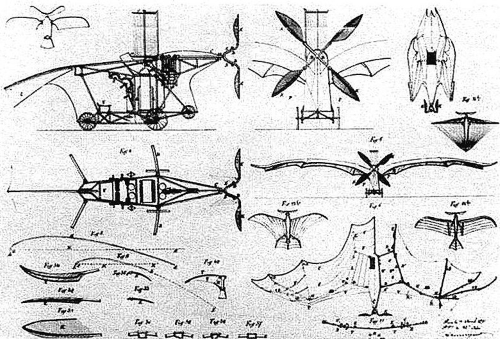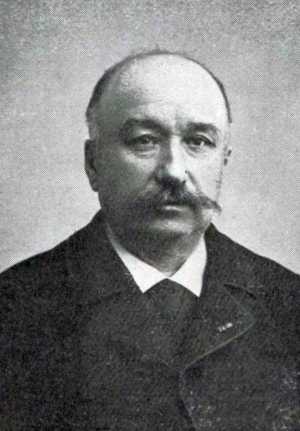Clément Ader was an inventor and engineer. He was born February 4th, 1841 in Muret, France and died on March 5, 1926.
Clément was a pioneer of flight predating the Wright brothers. He was an early aviation enthusiast.
During the Franco-German War of 1870-71, Ader constructed a balloon at his own expense, propelling his interest in aviation.
Related Article – 5 Best Low Time Pilot Jobs With 250 Hours
In 1876 he quit his government job at the Administration of Bridges and Highways to focus on his love of inventions.
One of his early inventions was an electrical communication system that included a microphone and a public-address speaker.
Next Ader worked on developing engine powered flying machines. In 1890 he built a steam-powered bat-wing monoplane called the Eole.

He flew the Eole a distance of 50 m (160 feet) on a flat field near Paris on October 9th, 1890.
The Wright Brother’s first flight didn’t take place until 1903.
With that said, there was a problem with the design of the Eole.
The steam engine was too heavy for longer flights and caused control issues for pilots due to the weight of the engine.
Ader’s short flight in the Eole was the first demonstration that a manned heavier-than-air flying machine could under its own power take-off from flat ground.
By 1897 Clément constructed a larger bat-like twin-prop machine which he named the Avion III.
The Avion III was known as the “Bat” due to the shape of its wings, and a restored Avion III is on display at the Musée des arts et métiers.

The Avion III is a twin steam engine plane with a wingspan of over 15 metres. It was completed in 1897 in Paris.
It was constructed of mainly wood and a small number of metal parts consisting of steel, brass and aluminium.
The covering for the wings was made from silk.
Related Article – Instrument Proficiency Check (IPC): 4 Things You Need To Know
Testing of the Avion III began in October 1897. Due to a lack of funding and resources, the work was not continued.
Ader did claim that a 300 meter flight had taken place, this was confirmed by two witnesses. This longer flight of his second plane was also before the Wright Brother’s first flight.
Biruta Kresling an architect studied the Avion III closely when it was taken apart.
Using her first-hand observations she produced a series of drawings of the Avion III.
She was amazed by the intuition shown by Ader in translating the mechanical principles of animal flight, particularly that of the bat and flying fox to the Avion III.
X-rays of the wing support arms of the Avion III showed its hollow inner to contain crisscrossed thin wooden rods.
These rods make the arm rigid and lightweight similar to the bone structure of birds.
Biruta Kresling detailed the aircraft’s design in her drawings, revealing the amazing bionic elements created by Clément Ader to mimic the flying fox mechanically.
It was inspired by nature and was a living machine.
General Pierre Lissarrague supervised restoration work on the plane.
He carried out a critical study of the technical notes in Clément Ader’s notebooks. He tested a mock-up of an original wing from the design of the Avion III plane.
The experiment took place outdoors, on the west coast of France.
Viewing the wing reacting to the high winds in the area the wing and membrane could be observed in simulated flight.
Lissarrague placed reflective strips under the wings to allow the shape of the wing profiles to be photographed at various wind speeds and positions.
The wing reacted and changed shape depending on the wind speed just as it would have in flight.
Although the ‘Bat’ plane isn’t widely known outside France. It was a remarkable achievement in aviation.
The Avion III was extremely advanced for the time.
From his testing and research, Ader recommended that designs based on the wings of bats were suitable for low-speed planes.
And designed based on the wings of birds were best suited for higher speed planes.
He developed many theories and innovations that are present in modern aircraft.
Ader invented a new propeller blade design.
The propeller was mounted so that it would flatten out at high speeds, automatically regulating the angle of the blade.
Modern propeller aircraft also modify the blade angle depending on the airspeed.
Ader’s flying machine was designed for military aviation.
Related Article – Airline Transport Pilot Certificate (ATP): 4 Things You Need To Know
A key feature he invented was that the wing could be folded back to make the plane easier to move and store.
A feature present in modern Navy planes to designed for use aboard aircraft carriers.
The Avion III was extremely advanced for the time. It was the first plane to take off from a level field.
Had wings with lightweight supports that could be folded to make the plane smaller for ease of storage.
Although the ‘Bat’ remains virtually unknown outside France. It was a remarkable achievement in aviation.

